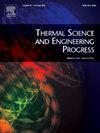Performance improvement of single slope solar distiller by using a novel corrugated–concave absorber: An experimental comparative study with energy, exergy, enviro–economic (4E), and sustainability assessments
IF 5.4
3区 工程技术
Q2 ENERGY & FUELS
引用次数: 0
Abstract
This work aims to study the effect of absorber shape designs on the thermal performance of single-slope solar distillers to achieve the highest daily output and lowest production cost. Three single-slope solar distillers with different water absorber designs, flat (SSSD-FA), concave (SSSD-CA), and corrugated-concave (SSSD-CCA) were proposed, tested, and compared under the same conditions in the Sfax region, central–eastern of Tunisia. The proposed absorbers were made of the same materials and had the same dimensions. It is worth noting that the corrugated-concave absorber shape is an innovative design and has not been considered in any previous studies. The corrugated-concave absorber design features an inward concave surface with a series of grooves (waves), providing a large surface area for evaporation that is exposed to incident solar radiation compared to a flat design of the same projected area. Thus increasing the evaporation rate and daily productivity. The outcomes showed that the daily yield enhanced by 33.54 % and 60.89 %, respectively, for SSSD-CA (4.10 Lm−2 day−1) and SSSD-CCA (4.94 Lm−2 day−1) compared with that of SSSD-FA. The SSSD-CCA enhanced the daily energy efficiency by 57.81 % and 18.52 % as compared to SSSD-FA and SSSD-CA, respectively. The energy payback period for SSSD-FA, SSSD-CA, and SSSD-CCA are 1.47 years, 1.31 years, and 1.28 years, respectively. The exergy payback period for SSSD-FA, SSSD-CA, and SSSD-CCA are 33.72 years, 24.95 years, and 21.85 years, respectively. The reduction in yield cost by SSSD-CA ($0.050 L−1) and SSSD-CCA ($0.042 L−1) was about 26 % and 50 %, respectively, as compared to the SSSD-FA. This indicates the novelty and feasibility of using the proposed corrugated-concave basin design in increasing the performance of solar stills while reducing the cost of distillation.
采用新型波纹-凹吸收体改善单坡太阳能蒸馏器性能:能源、能源、环境经济(4E)和可持续性评估的实验比较研究
本研究旨在研究吸收器形状设计对单坡太阳能蒸馏器热性能的影响,以达到最高日产量和最低生产成本。在突尼斯中东部的Sfax地区,提出了三种不同设计的单坡太阳能蒸馏器,分别是平面(SSSD-FA)、凹形(SSSD-CA)和波纹凹形(SSSD-CCA),并在相同的条件下进行了测试和比较。所提出的吸收器由相同的材料制成,具有相同的尺寸。值得注意的是,波纹凹形减振器的形状是一种创新的设计,在以往的研究中没有被考虑过。波纹-凹型吸收器设计的特点是具有一系列凹槽(波)的内向凹表面,与相同投影面积的平面设计相比,提供了更大的蒸发面积,暴露在入射太阳辐射下。从而提高蒸发速率和日产量。结果表明,与SSSD-FA相比,SSSD-CA (4.10 Lm−2 day−1)和SSSD-CCA (4.94 Lm−2 day−1)的日产量分别提高了33.54%和60.89%。与SSSD-FA和SSSD-CA相比,SSSD-CCA的日能效分别提高了57.81%和18.52%。SSSD-FA、SSSD-CA和SSSD-CCA的能源回收期分别为1.47年、1.31年和1.28年。SSSD-FA、SSSD-CA和SSSD-CCA的能源回收期分别为33.72年、24.95年和21.85年。与SSSD-FA相比,SSSD-CA (0.050 L−1美元)和SSSD-CCA (0.042 L−1美元)分别降低了约26%和50%的产量成本。这表明采用波纹凹槽设计在提高太阳能蒸馏器性能的同时降低蒸馏成本的新颖性和可行性。
本文章由计算机程序翻译,如有差异,请以英文原文为准。
求助全文
约1分钟内获得全文
求助全文
来源期刊

Thermal Science and Engineering Progress
Chemical Engineering-Fluid Flow and Transfer Processes
CiteScore
7.20
自引率
10.40%
发文量
327
审稿时长
41 days
期刊介绍:
Thermal Science and Engineering Progress (TSEP) publishes original, high-quality research articles that span activities ranging from fundamental scientific research and discussion of the more controversial thermodynamic theories, to developments in thermal engineering that are in many instances examples of the way scientists and engineers are addressing the challenges facing a growing population – smart cities and global warming – maximising thermodynamic efficiencies and minimising all heat losses. It is intended that these will be of current relevance and interest to industry, academia and other practitioners. It is evident that many specialised journals in thermal and, to some extent, in fluid disciplines tend to focus on topics that can be classified as fundamental in nature, or are ‘applied’ and near-market. Thermal Science and Engineering Progress will bridge the gap between these two areas, allowing authors to make an easy choice, should they or a journal editor feel that their papers are ‘out of scope’ when considering other journals. The range of topics covered by Thermal Science and Engineering Progress addresses the rapid rate of development being made in thermal transfer processes as they affect traditional fields, and important growth in the topical research areas of aerospace, thermal biological and medical systems, electronics and nano-technologies, renewable energy systems, food production (including agriculture), and the need to minimise man-made thermal impacts on climate change. Review articles on appropriate topics for TSEP are encouraged, although until TSEP is fully established, these will be limited in number. Before submitting such articles, please contact one of the Editors, or a member of the Editorial Advisory Board with an outline of your proposal and your expertise in the area of your review.
 求助内容:
求助内容: 应助结果提醒方式:
应助结果提醒方式:


